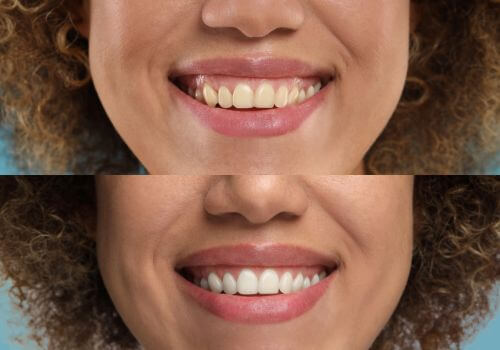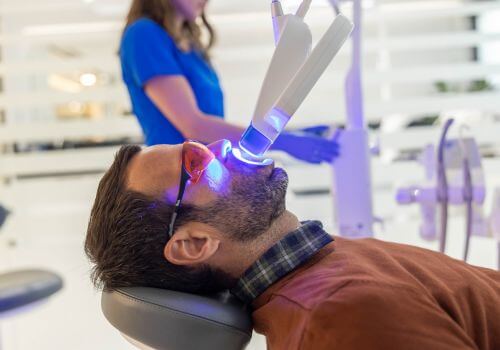Millions of people dream of achieving brighter, whiter smiles. While professional whitening treatments offer impressive results, many prefer the convenience and affordability of at-home options. As dental professionals, we understand the appeal of whitening your teeth in the comfort of your home — but knowing which methods work and how to use them safely is vital. Read on to learn about safe, effective at-home treatments for a whiter smile.
Understanding Tooth Discoloration
Before jumping into whitening solutions, it helps to understand why teeth become discolored in the first place.
Teeth stains fall into three categories:
1. Extrinsic stains: This type of stain affects the outer layer of your teeth (enamel) and is caused by foods, drinks, and lifestyle habits like:
- Coffee, tea, and red wine
- Dark berries and sauces
- Tobacco use
- Some medications
2. Intrinsic stains: These occur within the tooth structure and can result from:
- Aging
- Genetics
- Childhood antibiotic exposure
- Physical trauma to teeth
- Excessive fluoride exposure during childhood
3. Age-related stains: A combination of both intrinsic and extrinsic factors as enamel thins over time, revealing more of the naturally yellow dentin underneath.

Popular At-Home Whitening Methods
Store shelves burst at the seams with at-home whitening products promising dramatic results. But which ones actually work? Let’s take a closer look at several of the most popular options.
Whitening Toothpaste
Whitening toothpastes contain mild abrasives and sometimes low concentrations of hydrogen peroxide or other whiteners. They primarily remove surface stains.
Effectiveness: Typically provides one or two shades of whitening with consistent use.
Pros: Easy to incorporate into your routine; relatively inexpensive.
Cons: Limited effectiveness for deeper stains; can cause sensitivity with prolonged use.
Best For: Maintaining results after other whitening treatments or addressing mild surface stains.
Whitening Strips
These thin, flexible plastic strips are coated with hydrogen peroxide gel and adhere directly to your teeth. The peroxide penetrates the enamel to break down stains.
Effectiveness: Can lighten teeth two to four shades with proper use.
Pros: Convenient; relatively affordable; more effective than whitening toothpaste.
Cons: May cause sensitivity; uneven results if not applied correctly; can slip off teeth.
Best For: Moderate staining from coffee, tea, or wine; maintenance after professional treatments.
Whitening Gels and Pens
These products deliver peroxide-based whitening agents directly to teeth via a brush-on application.
Effectiveness: Results vary widely depending on formulation and application technique.
Pros: Targeted application; convenient for on-the-go touch-ups.
Cons: Easy to miss areas; shorter contact time than other methods; inconsistent results.
Best For: Touch-ups or spot treatment of specific teeth.
LED Whitening Kits
These increasingly popular kits combine whitening gel with an LED light device that claims to accelerate the whitening process.
Effectiveness: Can provide two to five shades of whitening with consistent use.
Pros: More effective than strips; can provide faster results.
Cons: Higher cost; mixed scientific evidence about LED effectiveness; potential sensitivity.
Best For: People seeking more dramatic results without professional treatment.
Custom-Fit Trays
This treatment uses custom trays made by your dentist that you fill with professional-grade whitening gel to use at home.
Effectiveness: Among the most effective at-home options, providing four to eight shades of improvement.
Pros: Professional supervision; custom fit minimizes gum irritation; even application.
Cons: Higher initial cost; requires dental visits for tray creation.
Best For: People with moderate to significant staining who want professional-level results.
Natural Remedies
Some people prefer natural approaches, such as oil pulling, activated charcoal, or baking soda. While these have passionate advocates, they typically offer limited whitening benefits.
Effectiveness: Limited effect beyond minimal surface stain removal.
Pros: Inexpensive; uses readily available ingredients.
Cons: Limited scientific evidence; some methods, like charcoal, can damage enamel with prolonged use.
Best For: People seeking the gentlest approach or those who prefer natural products.
Maximizing Safety and Results
Whichever method you choose, safety should always be your primary concern. Natural teeth are rarely paper white, so remember to set realistic expectations. Your results will vary based on your starting tooth color and the type of stains you’re dealing with. Also, keep in mind that dental crowns and fillings won’t whiten.
Before starting any whitening treatment, schedule a check-up with your dentist to address any existing cavities or gum disease.
Follow directions precisely. When it comes to whitening products, more is not better. Overuse increases the risk of sensitivity, so use products exactly as instructed. If you experience discomfort or sensitivity, take breaks between whitening sessions. Stop using whitening products and contact your dentist if discomfort persists.
To maintain your results, limit foods and beverages that stain teeth. Consider using a straw for dark drinks, and rinse your mouth after consuming coffee, wine, and other substances known to discolor teeth.
The Truth About Whitening Safety
When used as directed, most over-the-counter whitening products are considered safe.
However, misusing at-home whiteners can lead to:
- Temporary tooth sensitivity
- Gum irritation
- Uneven whitening
- Enamel damage (with excessive use)
Who Should Avoid At-Home Whitening?
Not everyone is an ideal candidate for at-home whitening.
Exercise caution if you:
- Have extensive restorations (crowns, veneers, large fillings)
- Experience severe tooth sensitivity
- Have receding gums or exposed roots
- Are pregnant or breastfeeding
- Are allergic to peroxide or other whitening ingredients
- Have severely discolored teeth that may require professional treatment
How Long Do Results Last?
Whitening results aren’t permanent. How long they last depends on several factors, including whitening method, lifestyle habits (smoking, coffee consumption, etc.), natural tooth structure, and oral hygiene routine.
Most people find that their results last anywhere from a few months to a year before touch-ups become necessary.

When to See a Professional
While at-home options can be effective, certain situations call for professional intervention.
Schedule an appointment with your dentist if any of the following applies to you:
- Severe or intrinsic discoloration
- Uneven results from at-home treatments
- Persistent sensitivity issues
- Desire for immediate, dramatic results
Professional treatments use higher-concentration whitening agents in a controlled environment, producing superior results in fewer sessions.
Final Thoughts
At-home teeth whitening offers a convenient and often effective solution for enhancing your smile. By choosing the right product for your needs and using it properly, you can achieve noticeable improvements in tooth color without compromising your oral health.
Consistency matters more than intensity. Gentle, regular whitening typically produces better long-term results than aggressive approaches. Always prioritize the health of your teeth and gums over cosmetic concerns, and take care to avoid damaging your enamel.
A brighter smile can boost confidence and make a positive impression, but the healthiest smile is one that’s properly cared for, regardless of its shade. If you have questions about how you can achieve the brilliant smile you’ve always wanted, schedule an appointment with your dentist.

